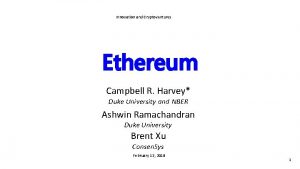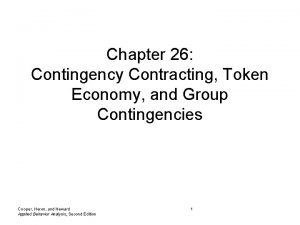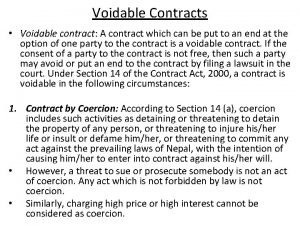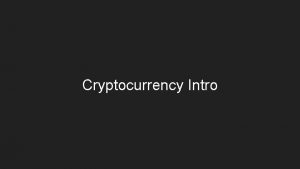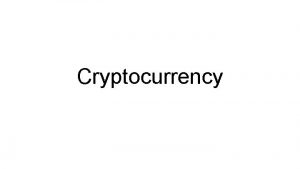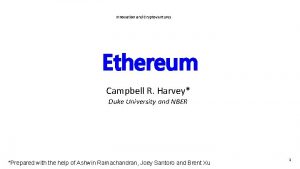Smart Contracts and Ethereum Winter School on Cryptocurrency



























 Private Storage def register(addr): if DNS: The “Hello World” of Ethereum data domains[](owner, ip) Private Storage def register(addr): if](https://slidetodoc.com/presentation_image_h2/ea3c7b497dc695a7d3c2cf212d55eced/image-28.jpg)



















































- Slides: 79

Smart Contracts and Ethereum Winter School on Cryptocurrency Loi Luu and Blockchain Technologies National University of Singapore Shanghai, Jan. 15 -17 2017 Some slides are courtesy of Vitalik Buterin 1

Agenda • • Smart contracts and applications Ethereum Interesting Ethereum-based projects Problems & challenges 2

SMART CONTRACTS 3

Definition A smart contract is a computer program executed in a secure environment that directly controls digital assets 4

A smart contract is a computer program executed in a secure environment that directly controls digital assets 5

A computer program is a collection of instructions that performs a specific task when executed by a computer. A computer requires programs to function, and typically executes the program's instructions in a central processing unit. Wikipedia 6

Example: bet on an event if HAS_EVENT_X_HAPPENED() is true: send(party_A, 1000) else: send(party_B, 1000) 7

A smart contract is a computer program executed in a secure environment that directly controls digital assets 8

Properties of Secure Environments • Correctness of execution – The execution is done correctly, is not tampered • Integrity of code and data • Optional properties – Confidentiality of code and data – Verifiability of execution – Availability for the programs running inside 9

Examples of secure environments • Servers run by trusted parties • Decentralized computer network (ie. blockchains) • Quasi-decentralized computer network (ie. consortium blockchains) • Servers secured by trusted hardware (e. g. SGX) 10

A smart contract is a computer program executed in a secure environment that directly controls digital assets 11

Example • Legal contract: “I promise to send you $100 if my lecture is rated 1*” • Smart contract: “I send $100 into a computer program executed in a secure environment which sends $100 to you if the rating of my lecture is 1*, otherwise it eventually sends $100 back to me” 12

A smart contract is a computer program executed in a secure environment that directly controls digital assets 13

What are digital assets? • A broad category – – – Domain name Website Money Anything tokenisable (e. g. gold, silver, stock share etc) Game items Network bandwidth, computation cycles 14

Example: top 5 crowdfunding campaigns in history 15

Star Citizen sold virtual spaceships in their game for $500 each 16

Ethereum Foundation sold 60, 102, 206 digital tokens which will be useful in a decentralized network 17

What are smart contracts’ applications? 18

Example: escrow service for exchange 19

Example: multisig • Require M of N “owners” to agree in order for a particular digital asset to be transferred – Individual use cases • eg. two-factor authentication – Intra-organizational use cases 20

A lot more interesting applications • Individual/intra-organizational – Complex access policies depending on amount, withdrawal limits, etc – Dead man’s switch, “digital will” • E. g When the owner dies, transfer all assets to someone • General – Prediction markets – Insurance – Micro-payments for computational services (file storage, bandwidth, computation, etc) 21

Why smart contracts? • Automated processing • Trust reduction – Trust the secure environments, not a very large number of contract enforcement mechanisms • Unambiguous, terms clearly expressed in code – Question: how to express terms clearly in code? 22

ETHEREUM: THE FIRST BLOCKCHAINBASED SMART CONTRACT PLATFORM 25

Ethereum • Blockchain with expressive programming language – Programming language makes it ideal for smart contracts • Why? – Most public blockchains are cryptocurrencies • Can only transfer coins between users – Smart contracts enable much more applications 26

Analogy: Most existing blockchain protocols were designed like ***** OR THIS 27

why not make a protocol that works like OR THIS 28

How Ethereum Works • Two types of account: – Normal account like in Bitcoin • has balance and address – Smart Contract account • • like an object: containing (i) code, and (ii) private storage (keyvalue storage) Code can – Send ETH to other accounts – Read/write storage – Call (ie. start execution in) other contracts 29
 Private Storage def register(addr): if](https://slidetodoc.com/presentation_image_h2/ea3c7b497dc695a7d3c2cf212d55eced/image-28.jpg)
DNS: The “Hello World” of Ethereum data domains[](owner, ip) Private Storage def register(addr): if not self. domains[addr]. owner: self. domains[addr]. owner = msg. sender Can be invoked by other accounts def set_ip(addr, ip): if self. domains[addr]. owner == msg. sender: self. domains[addr]. ip = ip 30

Ethereum Languages Looks like python Types, invariants, looks like Javascript Serpent Functional, macros, looks like scheme Solidity Lower-Level Language Ethereum VM Bytecode Stack Language Slide is courtesy of Andrew Miller Looks like Forth. Defined in Yellowpaper 31

Example What other see on the blockchain 60606040526040516102503 80380610250833981016040 528. . . . What you write PUSH 60 PUSH 40 MSTORE PUSH 0 CALLDATALOAD. . . What people get from the disassembler 32

Transactions in Ethereum • Normal transactions like Bitcoin transactions – Send tokens between accounts • Transactions to contracts – like function calls to objects – specify which object you are talking to, which function, and what data (if possible) • Transactions to create contracts 33

Transactions • • nonce (anti-replay-attack) to (destination address) value (amount of ETH to send) data (readable by contract code) gasprice (amount of ether per unit gas) startgas (maximum gas consumable) v, r, s (ECDSA signature values) 34

How to Create a Contract? • Submit a transaction to the blockchain – – – – nonce: previous nonce + 1 to: empty value: value sent to the new contract data: contains the code of the contract gasprice (amount of ether per unit gas) startgas (maximum gas consumable) v, r, s (ECDSA signature values) • If tx is successful – Returns the address of the new contract 35

How to Interact With a Contract? • Submit a transaction to the blockchain – – – – nonce: previous nonce + 1 to: contract address value: value sent to the new contract data: data supposed to be read by the contract gasprice (amount of ether per unit gas) startgas (maximum gas consumable) v, r, s (ECDSA signature values) • If tx is successful – Returns outputs from the contract (if applicable) 36

Blockchain State Bitcoin’s state consists of key value mapping addresses to account balance Address Balance (BTC) Ethereum’s state consists of key value mapping addresses to account objects Address Object 0 x 123456… 10 0 x 123456… X 0 x 1 a 2 b 3 f… 1 0 xab 123 d… 1. 1 Y 0 xab 123 d… Z Blockchain != Blockchain State 37

Account Object • Every account object contains 4 pieces of data: – Nonce – Balance – Code hash (code = empty string for normal accounts) – Storage trie root 38

Block Mining Tx-1 Block Tx-n Previous block Tx-2 A set of TXs New State Root Miners Verify transactions & execute all code to update the state Receipt Root SHA 3(Block) < D Broadcast Block Nonce 39

Code execution • Every (full) node on the blockchain processes every transaction and stores the entire state P 1 This is a new block! P 6 P 2 P 5 P 3 This is a new block! P 4 This is a new block! I’m a leader This is a new block! 40

Dos Attack Vector • Halting problem – Cannot tell whether or not a program will run infinitely – A malicious miner can Do. S attack full nodes by including lots of computation in their txs • Full nodes attacked when verifying the block uint i = 1; while (i++ > 0} ( donothing(); { 41

Solution: Gas • Charge fee per computational step (“gas”) – Special gas fees for operations that take up storage 42

Sender has to pay for the gas • gasprice: amount of ether per unit gas • startgas: maximum gas consumable – If startgas is less than needed • Out of gas exception, revert the state as if the TX has never happened • Sender still pays all the gas • TX fee = gasprice * consumedgas • Gas limit: similar to block size limit in Bitcoin – Total gas spent by all transactions in a block < Gas Limit 43

INTERESTING ETHEREUM-BASED PROJECTS 44

BTCRelay • A bridge between the Bitcoin blockchain & the Ethereum blockchain – Allow to verify Bitcoin transactions within Ethereum network – Allow Ethereum contracts to read information from Bitcoin blockchain Bitcoin Network BTCRelay Ethereum Network 45

BTCRelay – How it works Bitcoin Relayers constantly submit Bitcoin block headers A Bitcoin transaction is submitted, BTCRelay verifies TX based on the block header The verified Bitcoin transaction is relayed to the smart contract Ethereum 46

BTCRelay Application: ETH-BTC atomic swaps 50 ETH for anyone who sends 1 BTC to my address ETH-BTC Swap contract Check proof P BTCRelay I sent 1 Bitcoin to Alice address, here is the proof P Send 50 ETH Send 1 BTC to Alice address Bitcoin Network 47

BTCRelay Application: Contracts can read information of Bitcoin blockchain E. g. betting on the outcomes of events on Bitcoin blockchain 48

Other Work-in-progress Relays • Project Alchemy – Zcash relay • Dogecoin/ Litecoin Relay – Dogecoin light client on Ethereum by Vitalik – Interactive verification for Scrypt pow by Christian Question: can we build a decentralized exchange between cryptocurrencies using all the relays? 49

Smart. Pool • Decentralized Mining Pools using Smart Contracts • Problem: mining centralization – Miners go to mining pools for stable and frequent rewards – Decentralized platforms are secured by centralized entities • Transaction censorships • Single point of failures 50

Pooled mining • Pools track miners’ contribution by using shares – A share is similar to a block, but required less work to find Bitcoin Network Block Pool operator Shares 51

P 2 Pool: decentralized mining pool • Miners maintain the pool’s contributions by themselves – Maintain a share-chain within the pool (just like the blockchain) – Pay miners in proportional to their contributions • Done in the coinbase transaction • When a miner finds a share – Broadcast to all miners – Check if the coinbase tx is correct and extend the share-chain Bitcoin Network Block P 2 Pool Shares 52

Why P 2 Pool is Inefficient and not scalable? • Millions of messages per block (each per share) – Expensive to everyone • Reducing the number of shares? – No, will increase the variance of reward Bitcoin Network Block P 2 Pool Shares 53

Smart. Pool: Efficient P 2 Pool using Smart. Contract • Track miners’ contributions to the pool in a contract • Allows batch submissions, e. g. billions of shares in a claim – Reduce number of messages (txs) to the contract significantly • Use probabilistic verification to check a submission Smart. Pool Submit Sample &Check – Randomly verify only one share per submission – Probability of cheating being detected is proportional to the amount of cheating 54

Smart. Pool: Disincentivize cheating • Payment scheme: pay 0 for a submission if cheating detected – Expected reward is the same whether cheating or not – Miners have no incentive to cheat Reward = 1 passed Probabilistic verification detected Get 1. 5 Reward with 2/3 probability Get 0 Reward with 1/3 probability Expected reward = 1 55

More in the paper • How to prevent miners from stealing others’ shares? • How to prevent claiming a share multiple times – Within a submission – Across submissions • How to verify Ethash Po. W? – Require huge memory and storage 56

Smart. Pool. io is calling for donation 57

A lot more interesting apps • Town. Crier and Oraclize – allow contracts to fetch external data from real websites – Enable a lots of applications: betting, insurance, bounty based on real world event • Augur and Gnosis – Prediction market: predict the outcome of real world event to get reward • Many others: the. Dao, i. Conomi, Golem, etc 58

PROBLEMS/ CHALLENGES 59

Privacy • Ethereum blockchain guarantees correctness and availability, not privacy for smart contracts – Everything on the Ethereum blockchain is public • Cannot execute on private data (e. g. death will remains secret until the owner dies) • Transactions are traceable – Analysing transaction graph [IMC’ 13] 60

Privacy Solution • Hawk (Kosba et al. IEEE S&P’ 16) • Privacy-Preserving Smart Contracts • Execute confidential, fair, multiparty protocols • Zero. Cash over Ethereum, Ring signatures on Ethereum E E – Mixing coins with others E E 61

Scalability • Resources on blockchain are expensive – Full nodes perform the same on-chain computations – Full nodes store the same data • Gas-limit is relatively small – Can’t run an OS on blockchain – Can’t increase gas-limit: Do. S vector 62

Scalability Solution 1: Sharding • Divide the network into sub-networks – each stores and manages a fraction of the blockchain (a shard) – Allow scaling up as the network grows • There is a catch – May affect usability or performance – May not be compatible with all existing applications Shard 1 Shard 2 Shard 3 63

Scalability Solution 2: State Channel • Similar to payment channel (e. g. lightning network) but for states – Scaling by using off-chain transactions – Can update the state multiple times – Only settlement transactions are on-chain Blockchain Alice TX 1 Bob TX 2 X’s Initial State • Challenges – Cannot create state channel for all applications – Still early research, more work needed Contract X Many states i TX 3 TX 4 X’s Final State 64

Scalability Solutions: Other approaches • Storage rental – Problem: data fee is charged once – Idea: Charge more fees if store data longer • Similar to resource tax • Incentivize users to remove unnecessary data • Hardware-rooted trust – Using SGX to build state channel? (Inspired by teechan protocol) 65

Security Flaws • Due to abstraction of semantic – Transaction ordering dependence – Reentrancy bug • Which exploited the DAO • Obscure VM rules – Maximum stack depth is 1024: not many devs know – Inconsistent Exception Handling in EVM 66

Example 1: Transaction Ordering Dependence Puzzle. Solver Contract Balance: 100 Anyone can submit a solution to claim the reward Owner can update the reward anytime Puzzle. Solver() Set. Puzzle reward=100 Submit. Solution(solution) if is. Correct(solution): Send(reward) Update. Reward(new. Reward) reward=new. Reward 67

Scenario 1: Submit. Solution is trigerred +100 Puzzle. Solver Contract Balance: 100 0 Solution for Puzzle Random TXs Other TXs Block Random TXs Submit. Solution Miners Other TXs Puzzle. Solver() Set. Difficulty reward=100 Submit. Solution(solution) if is. Correct(solution): Send(reward) Update. Reward(new. Reward) reward=new. Reward 68

+0 Scenario 2: Both Submit. Solution and Update. Reward are triggered Puzzle. Solver Contract Balance: 0 Balance: 100 Solution for Puzzle Update Reward to $0! Other TXs Block Update. Reward = 0 Submit. Solution Miners Other TXs Puzzle. Solver() Set. Difficulty reward=100 Submit. Solution(solution) if is. Correct(solution): Send(reward) Update. Reward(new. Reward) reward=new. Reward 69

Transaction Ordering Dependence • Observed state != execution state • Transactions do not have atomicity property • Can be coincidence • Two transactions happen at the same time Solution for Puzzle Update Reward to $0! Other TXs 70

Transaction Ordering Dependence • Observed state != execution state • Transactions do not have atomicity property • Can be coincidence • Two transactions happen at the same time • Can be a malicious intention • Saw the targeted TX from the victim • Submit the second TX to update the reward • Both TXs enter the race Solution for Puzzle Update Reward to $0! Other TXs 71

Example 2: Reentrancy Bug --- The. DAO Bug • Reentrancy vulnerability – Most expensive vulnerability to date • Call before balance update. . . // Burn DAO Tokens if (balances[msg. sender] == 0) throw; withdraw. Reward. For(msg. sender); total. Supply -= balances[msg. sender]; balances[msg. sender] = 0; paid. Out[msg. sender] = 0; return true; 72

The. DAO Bug: Honest Secenario The. Dao split. DAO(proposal, address) Balance: 100 0 Payout : 100 0 withdraw. Reward. For(msg. sender) reward. Account. pay. Out(_account, reward) Receiver function() {} balances[msg. sender] = 0; 73

The. DAO Bug: Attack Scenario The. Dao split. DAO(proposal, address) Balance: Payout : 100 300 500 200 100 0 400 withdraw. Reward. For(msg. sender) Receiver reward. Account. pay. Out(_account, reward) split. DAO() 74

Solutions to Resolve Security Flaws • Create developer tools – Smart contract analyser based on symbolic exec: Oyente – Testing and deployment framework: truffle – Formal verification for smart contracts: eth-isabelle, why 3 • Design better semantic [CCS’ 16] • Educate users • Idea – Create security certificates for smart contracts? 75

Closing thought Ethereum and Smart contract are awesome, build your own Dapp today! – Pay more attention to security 76

Oyente: An Analyzer for Smart Contracts 77

Architecture • Based on symbolic execution • Have separate modules – Can add more analysis separately 6060604052123 123123528. . . Byte. Code Ethereum State CFG BUILDER EXPLORER CORE ANALYSIS Z 3 Bit-Vector Solver Visualizer VALIDATOR 78

Symbolic Execution Inputs Is there any value of x? T T F Symbolic Theorem Prover Formula NO YES T F F T T F Control T T F Execution Trace 79

What Can Oyente Do? • Detect Bugs In Existing Smart Contracts – Run with 19, 366 contracts – 30 mins timeout per contract • Test generation 6000 T Flagged Buggy Contracts T F 5411 5000 – Cover all possible paths of each program 4000 3000 2000 1000 0 F F 3056 T F T 1385 340 186 135 Callstack TOD Total Reentrancy Unique 83 52 Timestamp 80

Oyente is Open Source • https: //github. com/ethereum/oyente • Future work – Support more opcodes – Handle loops – Combine static and dynamic symbolic executions 81
 Tzarget
Tzarget Computer security 161 cryptocurrency lecture
Computer security 161 cryptocurrency lecture Anonymous eth mixer
Anonymous eth mixer Ethereum
Ethereum Szabo ethereum
Szabo ethereum Split manifold plug-in type
Split manifold plug-in type Blaockchain
Blaockchain Making smart contracts smarter
Making smart contracts smarter Winter kommt winter kommt flocken fallen nieder
Winter kommt winter kommt flocken fallen nieder Winter kommt flocken fallen nieder
Winter kommt flocken fallen nieder Es war eine mutter
Es war eine mutter Peristalsis
Peristalsis Street knowledge vs book knowledge
Street knowledge vs book knowledge One smart man he felt smart
One smart man he felt smart It's not how smart you are it's how you are smart meaning
It's not how smart you are it's how you are smart meaning Everfi smart shopping answers
Everfi smart shopping answers It's not how smart you are
It's not how smart you are Kim ung-yong
Kim ung-yong Street smart vs book smart quotes
Street smart vs book smart quotes One smart man he felt smart
One smart man he felt smart Forwards hedging
Forwards hedging Research and development contracts
Research and development contracts Magic school bus winter spring summer fall
Magic school bus winter spring summer fall Mitoc winter school
Mitoc winter school Winter law school elsa
Winter law school elsa School crossing patrol coat
School crossing patrol coat More things can be dissolved in sulfuric acid than in water
More things can be dissolved in sulfuric acid than in water Types of computer contracts
Types of computer contracts Litter picking contracts
Litter picking contracts Operation contract
Operation contract International contract
International contract What happened in 1872 in india
What happened in 1872 in india Mailbox rule contracts
Mailbox rule contracts Mailbox rule contracts
Mailbox rule contracts Parts of contracts
Parts of contracts Mailbox rule contracts
Mailbox rule contracts Financial contracting
Financial contracting Quasi contract meaning
Quasi contract meaning Mailbox rule contracts
Mailbox rule contracts Fututes
Fututes Classification of contracts
Classification of contracts Classification of contract
Classification of contract Ethical business strategies
Ethical business strategies Mailbox rule contracts
Mailbox rule contracts Group contingency definition
Group contingency definition Integrated social contracts theory maintains that
Integrated social contracts theory maintains that Ability one program
Ability one program Muscle contracts
Muscle contracts Perimysium
Perimysium Release muscle
Release muscle Ind as 11
Ind as 11 Ecm solutions group
Ecm solutions group Many mncs use forward contracts.
Many mncs use forward contracts. Depolarization of the heart
Depolarization of the heart Allied universal healthcare
Allied universal healthcare System operation contract
System operation contract Nadex short term contracts
Nadex short term contracts Contracts of agency
Contracts of agency Translating contracts
Translating contracts Common law and civil law
Common law and civil law Hsbc foreign exchange
Hsbc foreign exchange Features of forward contract
Features of forward contract Treaty reinsurance
Treaty reinsurance Spencer spanking plan
Spencer spanking plan Utility energy service contracts
Utility energy service contracts What is pre incorporation contracts in company law
What is pre incorporation contracts in company law Quasi contract meaning
Quasi contract meaning Voidable
Voidable Cell c phone contracts no credit checks
Cell c phone contracts no credit checks Title ii contracts
Title ii contracts As the solar nebula contracts, it
As the solar nebula contracts, it Example of universal principles
Example of universal principles Hot metal contracts as it grows cooler
Hot metal contracts as it grows cooler Milestone payments vs progress payments
Milestone payments vs progress payments What is a contingent contract
What is a contingent contract State of florida dms
State of florida dms Indiana state contracts
Indiana state contracts Wrongful acts that do not involve contracts
Wrongful acts that do not involve contracts Florida state term contract
Florida state term contract Wa des contracts
Wa des contracts



